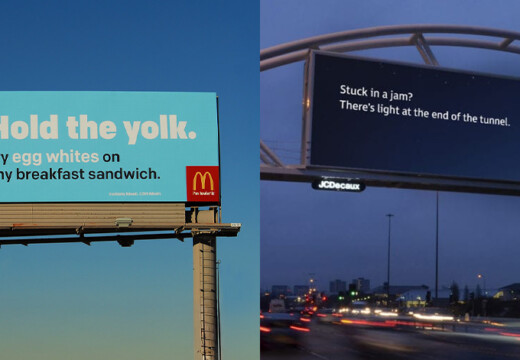Digital billboards significantly reduce waste compared to printed ones. Here’s why:
- No Physical Materials: Digital ads eliminate the need for vinyl, ink, and other non-recyclable materials used in traditional billboards.
- Energy Efficiency: Modern LED technology adjusts brightness based on light conditions, saving power. Some even integrate solar energy.
- Instant Updates: Content changes happen wirelessly, avoiding trips, manual labor, and material waste.
- Recyclable Components: Screens and hardware are designed for recycling, extending their lifespan and reducing e-waste.
Ep. 138 | Sustainable Digital Signage & Why It Matters
Physical Materials: Print vs. Digital Displays
Traditional billboards rely on a constant cycle of vinyl and ink replacements, while digital displays operate with a single hardware setup that can run multiple campaigns. This approach not only simplifies updates but also significantly cuts down on waste.
Material Usage Comparison
The differences in material usage between traditional and digital billboards are stark. Traditional billboards demand frequent replacement of vinyl and ink, which generates a steady stream of waste. On the other hand, digital billboards require a one-time investment in hardware, with occasional upgrades to components. This means that while traditional setups create ongoing waste, digital systems only need periodic maintenance, making them a more resource-efficient option.
Reducing Vinyl and Ink Waste
Digital displays take efficiency a step further by eliminating the need for non-recyclable materials like vinyl and ink. With traditional billboards, waste is not only produced during manufacturing and disposal but also from printing errors. In contrast, digital displays allow for instant content updates without any physical waste. While digital components do eventually require replacement, proper e-waste recycling helps mitigate their environmental impact, offering a cleaner, more sustainable advertising solution.
Power Usage and Efficiency
Modern digital billboards are designed with energy management features to minimize power consumption while maintaining top performance. These advancements help reduce their impact on the environment by incorporating smarter energy practices. Let’s take a closer look at how LED technology and light control systems play a role in achieving these energy savings.
LED Systems and Light Control
Digital billboards rely on energy-efficient LED technology that adapts brightness based on surrounding light conditions. For instance, during the day, the display increases brightness for better visibility. At night or in dimmer conditions, the system automatically lowers brightness, saving energy while still providing clear visuals. This dynamic adjustment is far more efficient than operating at a fixed brightness level.
Some key energy-saving practices include:
- Automatic dimming sensors that adjust brightness in real-time based on ambient light.
- Zone-based illumination, which lights up only the active areas of the display.
- Smart scheduling to reduce brightness during off-peak hours when traffic is lighter.
- Efficient heat management to reduce the need for cooling systems.
Solar Power Integration
Adding solar power systems to digital billboards is another way to reduce energy use. With battery storage, these systems can provide consistent power even during periods of limited sunlight. Advanced power management systems seamlessly coordinate between solar energy and the grid, ensuring uninterrupted operation while cutting utility costs and lowering the carbon footprint.
sbb-itb-2e2e93f
Digital Features Cut Operating Waste
Digital billboard technology helps minimize waste and simplifies ad updates by leveraging smart digital systems.
Wireless Content Updates
Digital billboards eliminate the need for physical updates by using wireless content management systems. This means no more:
- Multiple trips to manually update ads
- Physical materials for installation
- Disposing of outdated materials
- Storing bulky vinyl and print supplies
With remote updates, advertisers can tweak campaigns instantly, cutting down on carbon emissions and reducing installation-related waste. On top of that, digital billing models ensure ad budgets are used more efficiently.
Pay-Per-Play Systems
Pay-per-play systems charge advertisers only for the ads that are displayed. This approach reduces waste by:
- Allowing real-time adjustments to avoid running ineffective ads
- Providing flexible scheduling to prevent unused display time
- Starting campaigns with budgets as low as $20 per day
"Billboards are one of the most impactful ways to advertise, and with Blip, you spend a fraction of what you would end up paying elsewhere."
– Ray Bowens, Founder, Hashtag-Vape
Additionally, features like real-time bidding every 10 minutes ensure ads are displayed at the best times. By combining efficient spending with reduced waste, these systems perfectly complement the benefits of wireless digital updates.
Electronics Recycling and Maintenance
Recycling and regular maintenance play a key role in extending the lifespan of digital billboards while reducing electronic waste.
Screen and Component Recycling
Digital billboard screens are packed with materials that can be reclaimed and reused when processed correctly. Common components include:
- Precious metals in circuit boards
- Aluminum used in frames and housing
- Glass from the screen itself
- Recyclable plastics
Certified e-waste processors specialize in recovering and repurposing these materials, ensuring they don’t go to waste.
Parts Replacement and Repairs
With thoughtful maintenance and modular designs, digital billboards can stay operational longer, reducing the need for full replacements.
Why Modular Design Matters
- Individual LED panels can be swapped out without dismantling the entire display.
- Circuit boards and power supplies are designed for easy access and replacement.
- Cooling systems can be independently serviced, keeping the internal components safe from overheating.
Preventive Maintenance Tips
- Conduct visual inspections to spot wear and tear early.
- Regularly clean ventilation systems to prevent dust buildup.
- Perform electrical system checks to ensure smooth operation.
- Use diagnostic tools to identify potential issues before they escalate.
Conclusion: Digital Displays Cut Waste
Digital billboards are redefining advertising by reducing waste in ways traditional methods simply can’t match. By eliminating the need for physical materials, improving energy efficiency, and enabling instant updates, they present a smarter and more environmentally friendly approach to advertising.
This combination of efficient hardware and intelligent content delivery systems creates a practical solution for advertisers looking to minimize their environmental impact. Digital billboards are paving the way for a cleaner, more sustainable future in advertising while meeting the demands of modern marketing.
In short, they provide a forward-thinking, eco-conscious alternative for today’s advertisers.
FAQs
How do digital billboards support environmental sustainability?
Digital billboards offer a greener alternative to traditional ones by cutting out the need for physical materials like vinyl and paper. This shift not only reduces waste but also eliminates the environmental strain tied to printing and disposing of these materials.
On top of that, digital billboards make it easy to update content instantly, without the hassle of replacing physical displays. This approach uses fewer resources overall, making it a smarter, more eco-conscious choice for businesses looking to share their messages efficiently.
How do modern digital billboards save energy and reduce environmental impact?
Modern digital billboards are built with energy-saving technologies like LED lighting and advanced power systems, which help cut down on electricity use. LEDs not only consume less power than traditional lighting but also last much longer, reducing the need for frequent replacements. Many of these billboards are also equipped with smart sensors that adjust brightness based on surrounding light levels, ensuring clear visibility while using less energy.
Unlike traditional billboards that rely on materials like vinyl or paper, digital billboards eliminate the need for physical resources, significantly reducing waste. This combination of lower energy consumption and reduced waste makes them a greener option for advertising, aligning with efforts to minimize environmental impact.
How can digital billboards be maintained and recycled to reduce electronic waste?
Digital billboards can be cared for and recycled in ways that help cut down on electronic waste. Simple upkeep tasks – like cleaning the screens and ensuring proper ventilation – can make them last longer, reducing how often they need to be replaced. Plus, parts like LED panels and circuit boards can often be refurbished or recycled through dedicated e-waste programs.
Businesses can work with manufacturers and recycling facilities to ensure damaged or outdated components are responsibly handled, whether that means repurposing or proper disposal. Opting for energy-efficient, durable billboards also helps lower waste and reduces their overall environmental footprint.
Digital billboards offer a greener alternative to traditional ones by cutting out the need for physical materials like vinyl and paper. This shift not only reduces waste but also eliminates the environmental strain tied to printing and disposing of these materials.
On top of that, digital billboards make it easy to update content instantly, without the hassle of replacing physical displays. This approach uses fewer resources overall, making it a smarter, more eco-conscious choice for businesses looking to share their messages efficiently.
"}},{"@type":"Question","name":"How do modern digital billboards save energy and reduce environmental impact?","acceptedAnswer":{"@type":"Answer","text":"
Modern digital billboards are built with energy-saving technologies like LED lighting and advanced power systems, which help cut down on electricity use. LEDs not only consume less power than traditional lighting but also last much longer, reducing the need for frequent replacements. Many of these billboards are also equipped with smart sensors that adjust brightness based on surrounding light levels, ensuring clear visibility while using less energy.
Unlike traditional billboards that rely on materials like vinyl or paper, digital billboards eliminate the need for physical resources, significantly reducing waste. This combination of lower energy consumption and reduced waste makes them a greener option for advertising, aligning with efforts to minimize environmental impact.
"}},{"@type":"Question","name":"How can digital billboards be maintained and recycled to reduce electronic waste?","acceptedAnswer":{"@type":"Answer","text":"
Digital billboards can be cared for and recycled in ways that help cut down on electronic waste. Simple upkeep tasks - like cleaning the screens and ensuring proper ventilation - can make them last longer, reducing how often they need to be replaced. Plus, parts like LED panels and circuit boards can often be refurbished or recycled through dedicated e-waste programs.
Businesses can work with manufacturers and recycling facilities to ensure damaged or outdated components are responsibly handled, whether that means repurposing or proper disposal. Opting for energy-efficient, durable billboards also helps lower waste and reduces their overall environmental footprint.
"}}]}


